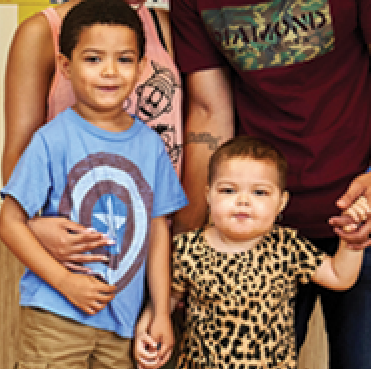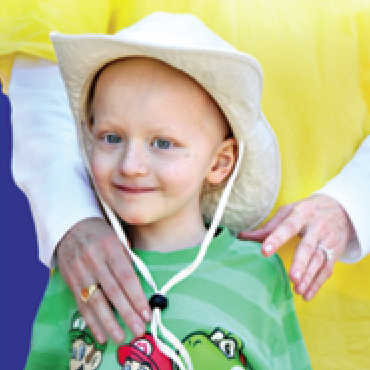 Sue and Ed Goldstein created The Valerie Fund in 1976 after losing their younger daughter Valerie to cancer. In Valerie’s memory, they were driven to make things better for other children and families fighting that same battle. In 1989 Sue and Ed’s older daughter Stacy was diagnosed with breast cancer and in 2001, at the age of 37, Stacy, too, lost her battle with cancer.
Sue and Ed Goldstein created The Valerie Fund in 1976 after losing their younger daughter Valerie to cancer. In Valerie’s memory, they were driven to make things better for other children and families fighting that same battle. In 1989 Sue and Ed’s older daughter Stacy was diagnosed with breast cancer and in 2001, at the age of 37, Stacy, too, lost her battle with cancer.
Sue was always in the forefront of getting the word out about The Valerie Fund and parenting a sick child. She co-wrote and co-produced the early Valerie Fund newsletters, and has just recently started writing for her personal blog.
What follows is an enlightening excerpt from Sue’s as-yet-unpublished memoirs titled “Unexpected Lives”. She describes the book as “...told from a mother’s perspective... the story of how one family confronts cancer in its only two children: Valerie, diagnosed when she was three, and years later, Stacy, diagnosed at twenty five." Sue uncovers her family’s will to live fully and enthusiastically. Hovering over all, however, is a dark cloud of uncertainty as ordinary people are faced with extraordinary illness.
"I saw Valerie – and the hall clock – as I raced away from the eleventh floor elevator. A wisp of a child, she stood with thin arms laced across her narrow chest and a comic frown transforming her impish face. Traffic into New York City had been heavy and I was five minutes late getting to Babies Hospital. I was in trouble.
 My five-year-old made this obvious as she pointed to the round black and white clock above the hall doorway. She knew exactly what she was doing. That clock was a tyrant with unyielding power, indifferent to all who passed by. I was no match for either one – my daughter or the clock. The rebuke dragged on. Valerie’s foot, tapping dramatically on the drab linoleum floor, punctuated her shout, “You’re late, Mommy. Where were you? I’ve been waiting!” It was a few minutes after ten on Wednesday morning. Val was in her Donald Duck nightgown. Faded and permanently stained with fingerpaint from the hospital playroom, it was much too big for her but the down-to-the-floor pink nightie was loved beyond reason.
My five-year-old made this obvious as she pointed to the round black and white clock above the hall doorway. She knew exactly what she was doing. That clock was a tyrant with unyielding power, indifferent to all who passed by. I was no match for either one – my daughter or the clock. The rebuke dragged on. Valerie’s foot, tapping dramatically on the drab linoleum floor, punctuated her shout, “You’re late, Mommy. Where were you? I’ve been waiting!” It was a few minutes after ten on Wednesday morning. Val was in her Donald Duck nightgown. Faded and permanently stained with fingerpaint from the hospital playroom, it was much too big for her but the down-to-the-floor pink nightie was loved beyond reason.
Her emerging smile quickened to a giggle, and, then, bursting with nervous laughter, she ran to me. I caught her in my arms and held on tight, repeating over and over, “SorrySorrySorry.” And I was never late again regardless of traffic. Not taking any chances, I called my friends the night before to confirm the 9:00 a.m. pick-up, got up earlier in the morning, spent a little less time with Stacy, packed a sleep over’s worth of goodies faster, and once my older one left for school, pushed my rides to speed.
Val’s two years of chemo had ended and she was now dealing with three days of medical testing in the search for residual cancer. She didn’t complain about the overnights, but misery shone from her eyes; they followed me everywhere that first night as I unpacked her favorite blanket and pillow. Valerie’s stuffed lion completed the picture and leaned cockeyed against the metal bed rail. It made her hospital room seem more homey, but my little girl didn’t smile. Oh God. What will they find this time? Nothing. Nothing.
Val knew the nurses on the floor from past inpatient stays and most catered to her whims. Since hospital rules prevented parents from sleeping over, the night staff assumed a surrogate’s role. Some handled it better than others. Easily dodging the issue of substitute, a widespread belief existed – and I, for one, was a believer –that the nurse in charge of your child was special, that she was a kind and loving stand-in.
Normally, I’d arrive at the hospital before ten, well ahead of the morning’s first tests. Valerie and I would then face unfamiliar medical staff, strange procedures, and weird equipment together. We’d spend the free time in Val’s room watching TV, reading to each other, and playing card games. In between, I followed her orders. “Mommy, I want some juice/an Oreo/Captain Crunch without milk/won-ton soup with only one won-ton, Mommy.” The soup required a trip outside the hospital to a nearby Chinese restaurant. Otherwise, I ran child-centered marathons up and down the eleventh floor hallways collecting whatever my daughter wanted. I was not alone. Other mothers ran beside me.
 Ed joined us at the end of his work day and was welcomed as member number two of Val’s private labor force. At that point, he and I took turns following Valerie’s commands. Every so often, though, when Val gave me permission, I sat in the parents’ lounge, feet up on the closest piece of furniture, and after adding ice from the eleventh floor’s fridge, drank my home-brewed iced tea. Poured into a large glass jar from home, the tea’s pale color was occasionally mistaken for a urine sample.
Ed joined us at the end of his work day and was welcomed as member number two of Val’s private labor force. At that point, he and I took turns following Valerie’s commands. Every so often, though, when Val gave me permission, I sat in the parents’ lounge, feet up on the closest piece of furniture, and after adding ice from the eleventh floor’s fridge, drank my home-brewed iced tea. Poured into a large glass jar from home, the tea’s pale color was occasionally mistaken for a urine sample.
Staying past visiting hours was common for us but finally we’d be forced to give Valerie a last hug and kiss goodnight and tuck her in. She knew that I would return early the next morning with a suitcase loaded with clean underwear, cookies, little toys, and comic greeting cards from friends and family. Leaving her room at the end of the day, Ed and I would rush to our car for the hour’s drive back home to New Jersey. We needed to tuck Stacy into bed. Listening to a brief summary of her day, I’d hug her, smooth her hair, touch her cheek, and try not to be too annoying. Ed gave her loud, mushy kisses and was very annoying. We made the Stacy-deadline more often than not. It was all in the timing.
Time. So precious. So scarce. It was my inner bully and confined me to boundaries shaped only by illness. Governed by that black and white hospital clock, my day was an either/or, here/there affair. Always in hurry mode, I rushed to get somewhere, anywhere on time, and was often late. I fought to beat the clock, to move faster, to advance ahead of speeding time, and somehow to slow it down.
When Val was diagnosed with bone cancer, Stacy, my healthy child, was abruptly thrust into the background. It was not my intention nor my desire. I worried about Stacy when we were apart, hustled to get back to her as soon as possible, and yet, when together, I yearned to be with her sister. Such were the overpowering demands made on behalf of the seriously chronically ill child. In the wake of that, I became marked by the belief that time, forever pictured in my mind as that round black and white clock, had to be accounted for every moment of every day. Can’t waste a second, not one second. And I wondered, will I ever be able to saunter through life again? Will I ever lose the sense of urgency that surrounds me now? Or the impatience that stalks its footsteps? Was that even possible? I surely don’t know. But time will tell. Won’t it?"
 After nine-year-old Valerie Goldstein lost her courageous fight against cancer in 1976, her parents Ed and Sue were determined to do something in her memory that would ease the burden of other families faced with the crisis of a sick child. They wanted Valerie’s courage to be memorialized in a meaningful way that would serve others in similar circumstances.
After nine-year-old Valerie Goldstein lost her courageous fight against cancer in 1976, her parents Ed and Sue were determined to do something in her memory that would ease the burden of other families faced with the crisis of a sick child. They wanted Valerie’s courage to be memorialized in a meaningful way that would serve others in similar circumstances.
The Valerie Fund was born in the Goldsteins' New Jersey basement - a group of benevolent friends supporting the Goldsteins’ wish that no family should have to endure what they had during Valerie’s treatment. The idea was simple: To provide families with regional outpatient treatment centers at top pediatric hospitals within an hour’s drive of most of the state’s population, providing state-of-the-art medical and emotional care in a happy, upbeat, child-centered atmosphere.
In 1977, The Valerie Fund Children's Center at Overlook Hospital opened, and became the first comprehensive care facility for children with cancer and blood disorders in New Jersey.









